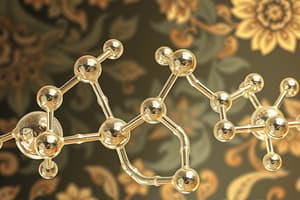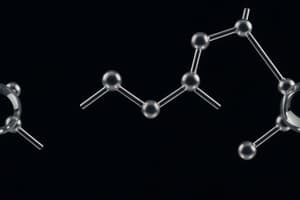Podcast
Questions and Answers
What type of intermolecular forces are present in small ester molecules?
What type of intermolecular forces are present in small ester molecules?
- Hydrogen bonding
- Dipole-Dipole interactions (correct)
- London dispersion forces
- Covalent bonds
All small ester molecules are insoluble in water.
All small ester molecules are insoluble in water.
False (B)
What is one practical use of esters in food production?
What is one practical use of esters in food production?
To give fruity flavourings
Each carbon atom in a benzene ring forms _____ sigma bonds.
Each carbon atom in a benzene ring forms _____ sigma bonds.
Match the following compounds with their natural or lab-made status:
Match the following compounds with their natural or lab-made status:
Which of the following statements about benzene is true?
Which of the following statements about benzene is true?
During the steam distillation process, the temperature can exceed the boiling point of the compound being extracted.
During the steam distillation process, the temperature can exceed the boiling point of the compound being extracted.
What is the appearance of the distillate collected from the extraction of clove oil?
What is the appearance of the distillate collected from the extraction of clove oil?
What is the purpose of adding cyclohexane to the distillate in the dropping funnel?
What is the purpose of adding cyclohexane to the distillate in the dropping funnel?
Cyclohexane is miscible with water.
Cyclohexane is miscible with water.
What is the systematic IUPAC name for the alcohol referred to as 'A'?
What is the systematic IUPAC name for the alcohol referred to as 'A'?
To dry the organic layer, one should shake it with __________ in a conical flask.
To dry the organic layer, one should shake it with __________ in a conical flask.
Match the following terms with their definitions:
Match the following terms with their definitions:
What should be done after shaking the mixture in the dropping funnel?
What should be done after shaking the mixture in the dropping funnel?
The boiling point of cyclohexane is 81 °C.
The boiling point of cyclohexane is 81 °C.
What is the structural difference between a primary alcohol and a secondary alcohol?
What is the structural difference between a primary alcohol and a secondary alcohol?
Which compound is an example of a chloroalkane?
Which compound is an example of a chloroalkane?
Chloroalkanes are soluble in water.
Chloroalkanes are soluble in water.
What is the general formula for alcohols?
What is the general formula for alcohols?
A primary alcohol has its -OH group attached to a carbon atom that is bonded to ______ other carbon atom(s).
A primary alcohol has its -OH group attached to a carbon atom that is bonded to ______ other carbon atom(s).
Match the following types of alcohols with their definitions:
Match the following types of alcohols with their definitions:
What distinguishes tertiary alcohols from primary and secondary alcohols?
What distinguishes tertiary alcohols from primary and secondary alcohols?
The process of creating ethanol from glucose involves the production of carbon dioxide.
The process of creating ethanol from glucose involves the production of carbon dioxide.
What is methanol commonly added to industrial ethanol to prevent drinking called?
What is methanol commonly added to industrial ethanol to prevent drinking called?
Which of the following alcohols is least likely to be soluble in water?
Which of the following alcohols is least likely to be soluble in water?
Carboxylic acids have higher boiling points than aldehydes.
Carboxylic acids have higher boiling points than aldehydes.
What is the functional group of aldehydes?
What is the functional group of aldehydes?
Esters are derived from carboxylic acids by replacing the H of the -OH group with an __________ group.
Esters are derived from carboxylic acids by replacing the H of the -OH group with an __________ group.
Match the following compounds with their uses:
Match the following compounds with their uses:
What happens to the solubility of carboxylic acids in water as their carbon chains increase in length?
What happens to the solubility of carboxylic acids in water as their carbon chains increase in length?
Ketones can have their carbonyl group located at the end of the carbon chain.
Ketones can have their carbonyl group located at the end of the carbon chain.
What is the general formula for esters?
What is the general formula for esters?
The process of forming an ester from an alcohol and a carboxylic acid is called __________.
The process of forming an ester from an alcohol and a carboxylic acid is called __________.
Which feature distinguishes carboxylic acids from other organic compounds?
Which feature distinguishes carboxylic acids from other organic compounds?
Flashcards
Ester Dipole-Dipole Forces
Ester Dipole-Dipole Forces
Ester molecules have polar C=O (carbonyl) bonds, leading to dipole-dipole interactions between molecules.
Ester Solubility in Water
Ester Solubility in Water
Small ester molecules can dissolve in water due to their dipole-dipole interactions, but larger esters are less soluble.
Benzene Carbon Bonding
Benzene Carbon Bonding
Each carbon atom in a benzene ring forms three sigma bonds: two with adjacent carbons and one with a hydrogen atom, and contributes to delocalised electrons.
Benzene Ring Stability
Benzene Ring Stability
Signup and view all the flashcards
Equal Carbon-Carbon Bond Lengths in Benzene
Equal Carbon-Carbon Bond Lengths in Benzene
Signup and view all the flashcards
Steam Distillation Definition
Steam Distillation Definition
Signup and view all the flashcards
Steam Distillation Setup
Steam Distillation Setup
Signup and view all the flashcards
Steam Distillation Procedure (Step 1)
Steam Distillation Procedure (Step 1)
Signup and view all the flashcards
Liquid-Liquid Extraction
Liquid-Liquid Extraction
Signup and view all the flashcards
Emulsion
Emulsion
Signup and view all the flashcards
Cyclohexane
Cyclohexane
Signup and view all the flashcards
Anhydrous Sodium Sulfate
Anhydrous Sodium Sulfate
Signup and view all the flashcards
Structural Isomers (Propan-2-ol & Propan-1-ol)
Structural Isomers (Propan-2-ol & Propan-1-ol)
Signup and view all the flashcards
Primary Alcohol
Primary Alcohol
Signup and view all the flashcards
Secondary Alcohol
Secondary Alcohol
Signup and view all the flashcards
Propan-2-ol
Propan-2-ol
Signup and view all the flashcards
Tetrahedral carbon
Tetrahedral carbon
Signup and view all the flashcards
Chloroalkane
Chloroalkane
Signup and view all the flashcards
Alcohols
Alcohols
Signup and view all the flashcards
Tertiary Alcohol
Tertiary Alcohol
Signup and view all the flashcards
Ethanol
Ethanol
Signup and view all the flashcards
Denatured Ethanol
Denatured Ethanol
Signup and view all the flashcards
Solubility of alcohols in water
Solubility of alcohols in water
Signup and view all the flashcards
Planar Carbon
Planar Carbon
Signup and view all the flashcards
Aldehyde Functional Group
Aldehyde Functional Group
Signup and view all the flashcards
Aldehyde Solubility
Aldehyde Solubility
Signup and view all the flashcards
Ketone Functional Group
Ketone Functional Group
Signup and view all the flashcards
Ketone Solubility
Ketone Solubility
Signup and view all the flashcards
Carboxylic Acid Formula
Carboxylic Acid Formula
Signup and view all the flashcards
Carboxylic Acid Naming
Carboxylic Acid Naming
Signup and view all the flashcards
Ester General Formula
Ester General Formula
Signup and view all the flashcards
Ester Naming
Ester Naming
Signup and view all the flashcards
Study Notes
Organic Compounds
- Tetrahedral Compounds
- A tetrahedral carbon atom has four single bonds.
- Chloroalkanes are compounds where hydrogen atoms in an alkane are replaced by chlorine.
- Examples include monochloromethane, dichloromethane, trichloromethane (chloroform), and tetrachloromethane.
- Used as solvents for removing oil and grease.
- Not soluble in water but soluble in non-polar solvents.
- Liquid at room temperature.
Alcohols
-
Definition
- Functional group responsible for characteristic properties of an organic compound.
- Derived from alkanes by replacing a hydrogen atom with an -OH group.
- General formula: CnH2n+1OH
- Named by changing the -e in the alkane name to -ol.
- Example: Ethanol (C2H5OH), found in alcoholic drinks.
-
Types of Alcohols
- Primary alcohols: The carbon atom attached to the -OH group is attached to only one other carbon atom.
- Secondary alcohols: The carbon atom attached to the -OH group is attached to two other carbon atoms.
- Tertiary alcohols: The carbon atom attached to the -OH group is attached to three other carbon atoms.
- Alcohols have higher boiling points than their corresponding alkanes due to hydrogen bonding.
Planar Compounds
- Definition
- A planar carbon atom has planar geometry, occurring when the carbon atom is unsaturated (contains a double or triple bond).
Aldehydes
- Definition
- Homologous series of organic compounds containing the -CHO functional group.
- Named from the parent alkane by changing the -e to -al.
- Dipole–dipole interactions result in higher boiling points than their corresponding alkanes.
Ketones
- Definition
- Homologous series of organic compounds containing the >C=O functional group.
- Named by changing the -e in the parent alkane name to -one.
- Carbonyl group is located on a central carbon atom.
- Boiling points are higher than their corresponding alkanes due to dipole–dipole forces but lower than alcohols due to no hydrogen bonds.
Carboxylic Acids
- Definition
- Family of organic compounds containing the -COOH carboxyl group.
- General formula: CnH2n+1COOH
- Named by changing the -e in the parent alkane name to -oic acid
- Higher boiling points due to relatively strong hydrogen bonds between carboxylic acid molecules
- Solubility in water due to hydrogen bonding in small carboxylic acids.
Esters
- Definition
- Family of compounds with the general formula RCOOR' and the -COO- functional group.
- Derived from carboxylic acids and alcohols
- Prepared by a condensation reaction, which is a chemical reaction where two molecules combine to form a larger molecule and loss of a smaller molecule like water.
- Name the alcohol derived section first, then the carboxylic acid section ("-oic acid" changes to "-oate").
- Have dipole-dipole intermolecular forces.
- Small ester molecules are soluble in water.
- Used in flavors and perfumes.
Aromatic Compounds (Benzene)
- Each carbon atom in the benzene ring uses three electrons to form sigma bonds by head-on overlap of atomic orbitals.
- The remaining valence electrons are shared between all 6 carbon atoms creating delocalized electrons giving the benzene molecule extra stability.
- Bond lengths between all carbon atoms are equal.
Steam Distillation
- A separation process used to isolate compounds at temperatures below their composition temperatures.
- Bubbling steam through the material distills off the immiscible liquids.
Liquid-Liquid Extraction
- Used to separate clove oil from an emulsion of clove oil and water using cyclohexane.
- Add cyclohexane to the distillate, shake the mixture, remove the aqueous layer, and dry the organic layer
- Separate cyclohexane from the clove oil by placing the mixture on a water bath in a fume cupboard.
Exam Questions (examples)
- Systematic (IUPAC) name for Propan-2-ol and Propyl methanoate.
- Structural differences between primary and secondary alcohols.
- Identification of structural isomers.
- Compound with tetrahedral geometry.
- Reagents & catalysts for conversions on a reaction scheme.
- Oxidation of propanal by Fehling's reagent (procedure & why propanone doesn't react).
- Compound with fruity odour in a reaction scheme.
Studying That Suits You
Use AI to generate personalized quizzes and flashcards to suit your learning preferences.
Related Documents
Description
Explore the fascinating world of organic compounds, focusing on tetrahedral structures and alcohols. Understand the characteristics and examples of chloroalkanes and delve into the definition and types of alcohols. This quiz is designed to test your knowledge on these important organic chemistry topics.




